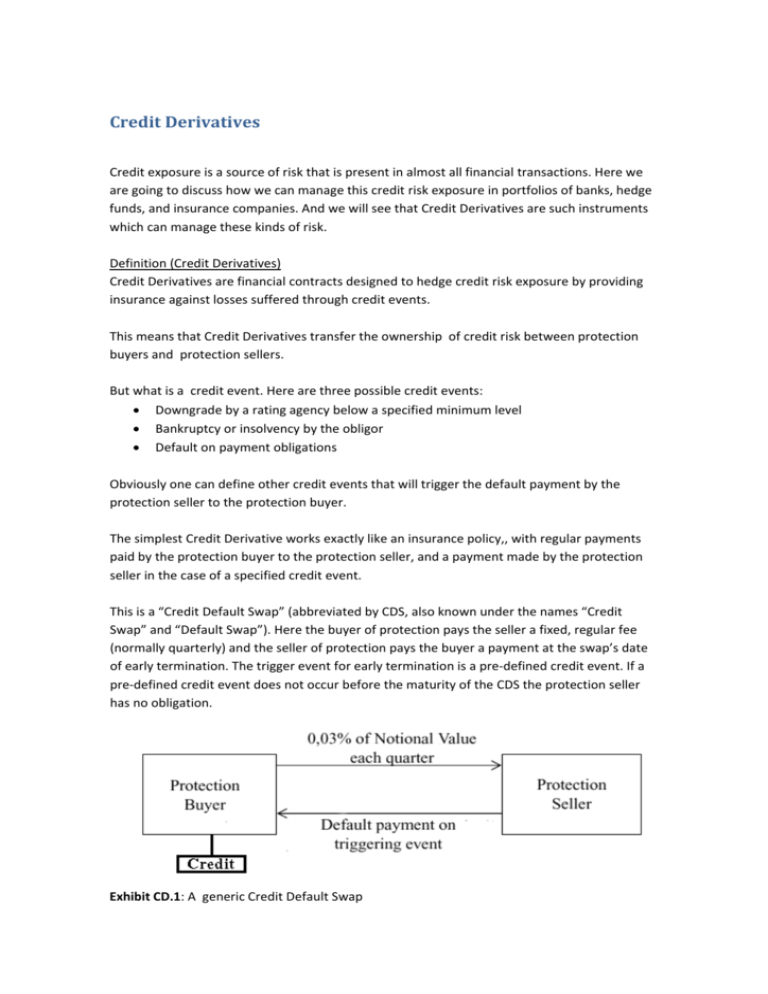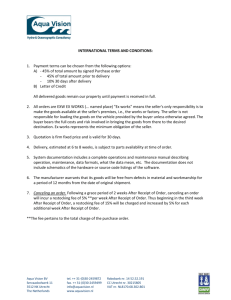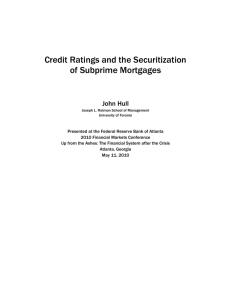Credit Derivatives
advertisement

Credit Derivatives Credit exposure is a source of risk that is present in almost all financial transactions. Here we are going to discuss how we can manage this credit risk exposure in portfolios of banks, hedge funds, and insurance companies. And we will see that Credit Derivatives are such instruments which can manage these kinds of risk. Definition (Credit Derivatives) Credit Derivatives are financial contracts designed to hedge credit risk exposure by providing insurance against losses suffered through credit events. This means that Credit Derivatives transfer the ownership of credit risk between protection buyers and protection sellers. But what is a credit event. Here are three possible credit events: • Downgrade by a rating agency below a specified minimum level • Bankruptcy or insolvency by the obligor • Default on payment obligations Obviously one can define other credit events that will trigger the default payment by the protection seller to the protection buyer. The simplest Credit Derivative works exactly like an insurance policy,, with regular payments paid by the protection buyer to the protection seller, and a payment made by the protection seller in the case of a specified credit event. This is a “Credit Default Swap” (abbreviated by CDS, also known under the names “Credit Swap” and “Default Swap”). Here the buyer of protection pays the seller a fixed, regular fee (normally quarterly) and the seller of protection pays the buyer a payment at the swap’s date of early termination. The trigger event for early termination is a pre‐defined credit event. If a pre‐defined credit event does not occur before the maturity of the CDS the protection seller has no obligation. Exhibit CD.1: A generic Credit Default Swap This Credit Derivative is the most common one in the Credit Derivatives Market. The occurrence of CDS lies by over 50 % of the market. Now let us talk about another Credit Derivative, the “Total Return Swap” (also known under the name “Total Rate of Return Swap”) A Total Return Swap (TRS) is a derivative contract that simulates the purchase of an instrument (financial asset) with 100% financing, typically by a floating rate. The floating rate is almost ever a spread to LIBOR. It is one of the principal instruments used by banks or other financial institutions to manage their credit risk exposure. The next figure illustrates a generic TRS: Exhibit CD.2: A Total Return Swap If there is any appreciation in the market the Protection Seller receives any increase in value of the instrument, and the Protection Buyer receives any decrease in value of the instrument. Here the investor (our Protection Buyer) is the legal owner of the instrument and the TRS is an off‐balance sheet transaction. Which implies that the instrument does not appear on the balance sheet of the receiver (our Protection Seller). If the obligor of the instrument defaults, the swap is terminated immediately with a net present value payment (agreed on before the default date) between Protection Buyer and Seller. A Credit Option is an over‐the‐counter contract designed to meet specific hedging requirements of a financial institution, which may purchase or sell the option to meet its objectives. A credit call option gives the buyer the right to purchase a credit spread at a specified price (the strike price) and a specified period of time. A credit put option gives the buyer the right to sell a credit spread at a specified price (the strike price) and a specified period of time. The payoff of a credit option can be contingent of the following credit events (Bieleciki et al., 2004): • The price of a underlying asset drops below a strike price • • The credit for a underlying asset tightens or widens There is a default event on the company who held the underlying asset Let us speak now about Collateralized Debt Obligations. It’s a structured finance product where a pool of debt issues (bonds, loans, etc.) are put into a special purpose trust. But to be more specific: A bank pools together bonds or loans which have been purchased or taken out by their clients. This pool is transferred to an off‐balance sheet trust called a bankruptcy‐remote special‐purpose vehicle (“SPV”). The SPV issues coupon‐bearing financial securities. The bonds or loans repayments are directed towards the SPV. After deducting expenses, the SPVS uses these repayments to pay the coupons of the securities. (Donnelly et al., 2010) The following figure shows a generic CDO: Exhibit CD.3: A Collateralized Debt Obligation The means for purchasing the underlying assets are raised through the issue of bonds which may result in parting the CDO in one or more tranches and an Equity Note. A senior tranche is considered the safest security. Interest and principal payments are made in order of seniority, so that junior tranches offer higher coupon payments or lower prices to compensate for higher default risk. This different risk and return characteristics of the different tranches are what makes them attractive for different investors. Here is a nice picture of the functioning of a CDO presented by Wikipedia.: Think of a cash flow from the pool of underlying assets as water flowing into the cups of the investors in the senior tranches first, then junior tranches, then equity tranches. If a large portion of, say bonds in the pool enter into default, there is insufficient cash flow to fill all these cups and equity tranch investors face the losses first. CDO’s are mainly about repackaging and transferring credit risk. And exactly that makes them so difficult to analyze. Not only is there an entire pool of securities (bonds, loans, etc.) to analyze. On top of this is the added complexity of the tranching, which must be analyzed too. Sophisticated portfolio credit risk models should be used here. (Holton, 2007)








